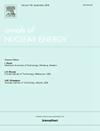SPARTA: A flux adjustment methodology to interpret complex experiments
IF 1.9
3区 工程技术
Q1 NUCLEAR SCIENCE & TECHNOLOGY
引用次数: 0
Abstract
To accurately determine reactivity from a detector count rate, correcting spatial effects is of prime importance. Simulation methodologies are often used for spatial correction, but they may introduce an additional source of uncertainty if the results of the experiment are also used as the input data for the simulation. This work presents a flux adjustment methodology that can infer experimental reactivity and correct spatial effects without the need for a simulation. It can process the detector signal(s) from a complex experiment, such as a heat balance measurement in the Transient Reactor Test Facility (TREAT) in which control rods are continuously adjusted to maintain a constant power. The methodology presented in this work successfully computed the reactivity and the local spatial variation of the flux from a generated signal. It also proved to be robust against noise and errors on kinetic parameters and provided a credible interpretation of a heat balance experiment in TREAT. An efficient flux adjustment method for complex experiments enables better experiment interpretation that is less reliant on nuclear data evaluations.
斯巴达:解释复杂实验的通量调整方法
为了从检测器计数率中准确地确定反应性,校正空间效应是最重要的。模拟方法通常用于空间校正,但如果实验结果也用作模拟的输入数据,它们可能会引入额外的不确定性来源。这项工作提出了一种通量调整方法,可以推断实验反应性和纠正空间效应,而不需要模拟。它可以处理来自复杂实验的探测器信号,例如瞬态反应堆测试设施(TREAT)中的热平衡测量,其中控制棒不断调整以保持恒定的功率。本文提出的方法成功地计算了一个产生的信号的反应性和局部空间变化。它还证明了对噪声和动力学参数误差的鲁棒性,并为TREAT的热平衡实验提供了可信的解释。复杂实验的有效通量调整方法可以更好地解释实验,减少对核数据评价的依赖。
本文章由计算机程序翻译,如有差异,请以英文原文为准。
求助全文
约1分钟内获得全文
求助全文
来源期刊

Annals of Nuclear Energy
工程技术-核科学技术
CiteScore
4.30
自引率
21.10%
发文量
632
审稿时长
7.3 months
期刊介绍:
Annals of Nuclear Energy provides an international medium for the communication of original research, ideas and developments in all areas of the field of nuclear energy science and technology. Its scope embraces nuclear fuel reserves, fuel cycles and cost, materials, processing, system and component technology (fission only), design and optimization, direct conversion of nuclear energy sources, environmental control, reactor physics, heat transfer and fluid dynamics, structural analysis, fuel management, future developments, nuclear fuel and safety, nuclear aerosol, neutron physics, computer technology (both software and hardware), risk assessment, radioactive waste disposal and reactor thermal hydraulics. Papers submitted to Annals need to demonstrate a clear link to nuclear power generation/nuclear engineering. Papers which deal with pure nuclear physics, pure health physics, imaging, or attenuation and shielding properties of concretes and various geological materials are not within the scope of the journal. Also, papers that deal with policy or economics are not within the scope of the journal.
 求助内容:
求助内容: 应助结果提醒方式:
应助结果提醒方式:


